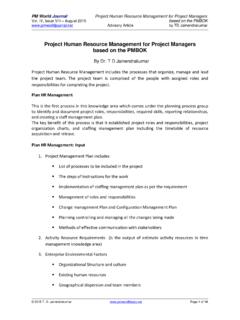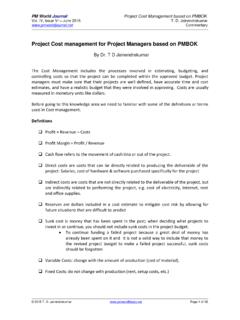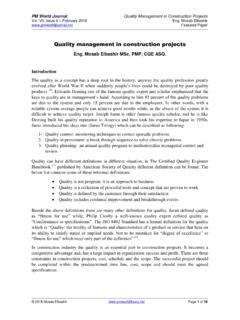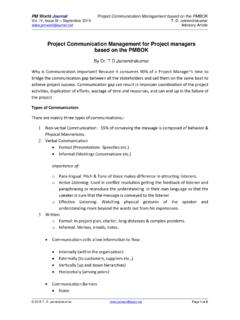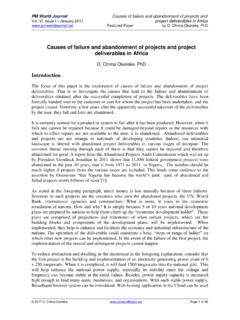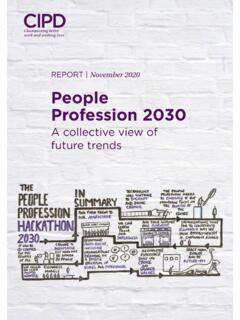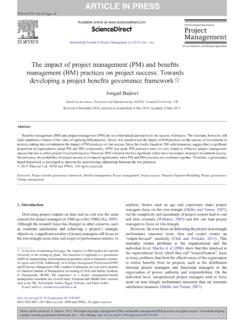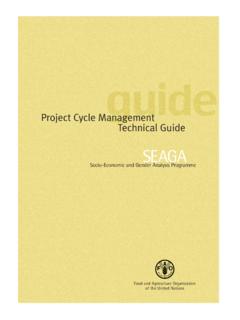Transcription of Project interfaces and their management - PM World Library
1 PM World Journal Project interfaces and their management Vol. V, Issue VII July 2016 Project Integration, interfaces & Context Series Article by Alan Stretton Series on Project integration, interfaces and context management1. Article 2 of 3. Project interfaces and their management By Alan Stretton INTRODUCTION. This series of three articles is concerned with Project integration. The first article (Stretton 2016h) was essentially an overview of the literature on Project integration per se. In spite of its perceived importance to Project management , materials specific to the subject are somewhat scarce, fragmented, and disparate, and do not provide good insights about the essential elements of Project integration. The first article noted that many authors strongly associate Project integration with Project interfaces and their management , and signalled that this second article will look at the rather modest materials on Project interface management in more detail (which hopefully may provide further insights about Project integration at large).
2 It will be found that different authors have different perceptions of the nature of Project interfaces , and of which they see as the important ones. Over thirty Project interfaces are identified, and are broadly classified and accumulated into a table. This could be seen as a basic checklist for Project managers who are establishing and/or managing this component of Project integration. It also provides a listing of Project contexts which are relevant to the third article of this series. LINKS BETWEEN Project INTEGRATION AND Project interface MGT. In the first article it was pointed out that many writers link Project integration with Project interface management . For example, Stuckenbruck 1988 said: Project managers carry out their function of Project integration primarily by carefully managing all of the many diverse interfaces within their projects. Struen 2011 also links the two very directly: Need for integration of Project processes is evident when interfaces must be established for the processes to interact.
3 This second article looks in more detail at Project interfaces and their management . 1. Editor's note: This series of articles is by Alan Stretton, PhD (Hon), Life Fellow of AIPM (Australia), a pioneer in the field of professional Project management and one of the most widely recognized voices in the practice of program and Project management . Long retired, Alan is still accepting some of the most challenging writing assignments; he is a frequent contributor to the PM World Journal. See his author profile at end of this article. 2016 Alan Stretton Page 1 of 12. PM World Journal Project interfaces and their management Vol. V, Issue VII July 2016 Project Integration, interfaces & Context Series Article by Alan Stretton THE NATURE OF Project interfaces . In the following I draw heavily on just a few authors who appear to have made the biggest contributions in this area. Healy 1997. Healy 1997:268 describes Project interfaces rather succinctly as follows.
4 An interface is a boundary where an interdependency exists across that boundary and where responsibility for the interdependency changes across that boundary. Healy goes on to say ( ) that interfaces arise because work is broken down into parts and each of the parts is carried out by or executed by different people or organisations. The definition of the parts may depend on technology, on economics, on geography or a host of other factors.. The Project manager can also impose interfaces to help in the management of the Project .. No matter how the work is divided up, there is always the problem of linking the various parts and so a need for interface management . Healy 1997:Ch 12 effectively has the following three broad categories of interfaces . o Interfacing the client o Maintaining external interfaces o Managing internal interfaces Morris 1988. Morris 1988:18 introduces the subject of interfaces from a systems perspective.
5 During the 1950s, work in economics, psychology, sociology, anthropology and other disciplines developed .. open-system ideas by elaborating the importance of systems' boundaries and interfaces .. Having introduced interfaces via this systems perspective, Morris goes on to relate this to Project management , partly as follows. The systems perspective has contributed substantially to the development of Project management . Firstly, the systems emphasis on viewing a system as a whole has frequently been behind the recognition of the need for an across-the-board integrating role that is, for Project management itself. Here, Morris has developed a systems approach to directly equate Project management with an across-the-board integrating role, and has noted the importance of systems boundaries and interfaces in undertaking this role. 2016 Alan Stretton Page 2 of 12. PM World Journal Project interfaces and their management Vol.
6 V, Issue VII July 2016 Project Integration, interfaces & Context Series Article by Alan Stretton In the context of managing Project interfaces , Morris distinguishes between three sets of Project subsystems in his Figure 2-3. Project /outside World static subsystems. Dynamic interfaces .. Morris says the dynamic interfaces arise as a function of the pattern of activity interdependencies generated by the way the Project develops . These include interfaces between life-cycle or activity subsystems. Intra- Project static subsystems. We will be looking further at Morris' subsystems/ interfaces later. For the moment we note that he has broadly distinguished between interfaces external to the Project , and internal interfaces . He shares this attribute with Healy's above categorisation. Stuckenbruck 1988. Stuckenbruck 1988 also broadly classifies Project interfaces , but in a different way: o personal interfaces , o organisational interfaces , and o system interfaces .
7 We now briefly look at what various authors have had to say about the management of Project interfaces . Project interface management . Despite its importance in Project management , interface management has been given little attention (Healy 1997: 267). Healy 1997:268 describes interface management as follows. interface management then is the management of the interdependencies and responsibilities across the boundaries of the interface . Morris 1988 also mentions interdependencies in a systems context. He says that, typically, the activities of subsystems in a Project create certain interdependencies: o technical, o organizational, and o environmental He goes on to observe that these interdependencies may be almost accidental or may be deliberately organized. Morris also says that interface management identifies the following: 2016 Alan Stretton Page 3 of 12. PM World Journal Project interfaces and their management Vol.
8 V, Issue VII July 2016 Project Integration, interfaces & Context Series Article by Alan Stretton The subsystems to be managed on a Project , The principal subsystem interfaces requiring attention, The ways in which these interactions should be managed successfully Archibald 1976 responded to his own question What is meant by interface management ? as follows. interface management consists of identifying, documenting, scheduling, communicating, and monitoring interfaces related to both the product and the Project . Stuckenbruck 1988 says that Project integration and interface management are virtually one and the same. Project integration is just another way of saying interface management since it involves continually monitoring and controlling ( managing) a large number of Project interfaces . I am not sure that we have gained any substantial further insights into Project interfaces in this quick survey of what some authors have said about their management .
9 their descriptors of what is involved are rather mixed. I therefore propose to look further at types of Project interfaces . I found many more different types than I had initially expected, and spent some time trying to work out how best to categorise them. The first broad categorisation that appeared to make sense was to distinguish between interfaces which are external to the Project , and internal ones. A VERY BROAD GROUPING OF Project interfaces INTO INTERNAL AND. EXTERNAL CATEGORIES. A basic internal / external model Project interfaces can be broadly categorised into: Internal interfaces interfaces within the Project itself, and External interfaces interfaces that the Project has with external entities. However, I came across a problem here, which can best be explained by first distinguishing between two types of organizations that undertake projects, which I. call production- based organization and Project - based organizations.
10 Distinguishing between production- based and Project - based organizations I follow Cooke-Davies 2002 in describing these two types as production- based and Project - based organizations, and borrow from Archibald et al 2012 (who use different descriptors) in defining them: 2016 Alan Stretton Page 4 of 12. PM World Journal Project interfaces and their management Vol. V, Issue VII July 2016 Project Integration, interfaces & Context Series Article by Alan Stretton Production- based organizations derive most (if not all) of their revenue and/or benefits from producing and selling products and services. They utilize projects to create or improve new products and services, enter new markets, or otherwise improve or change their organizations. Project - based organizations derive most (if not all) of their revenue and/or other benefits from creating and delivering projects. In the case of Project - based organizations, we can clearly differentiate between internal Project interfaces on the one hand, and interfaces with the Project 's external environment on the other.
